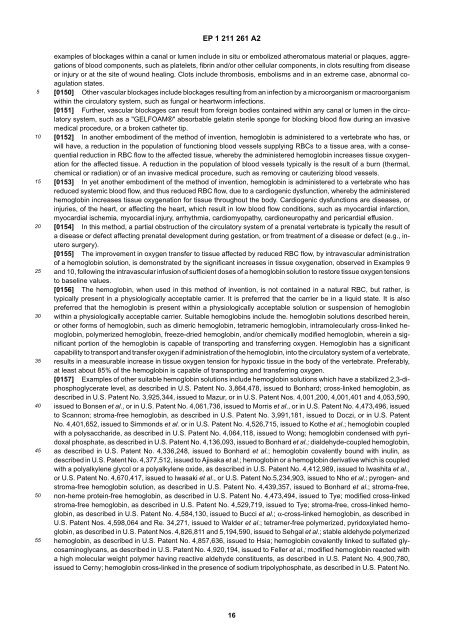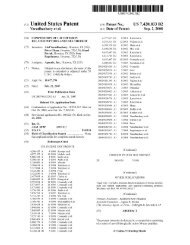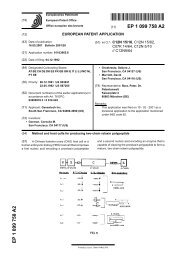EP 1 211 261 A2
EP 1 211 261 A2
EP 1 211 261 A2
Create successful ePaper yourself
Turn your PDF publications into a flip-book with our unique Google optimized e-Paper software.
<strong>EP</strong> 1 <strong>211</strong> <strong>261</strong> <strong>A2</strong>510152025303540455055examples of blockages within a canal or lumen include in situ or embolized atheromatous material or plaques, aggregationsof blood components, such as platelets, fibrin and/or other cellular components, in clots resulting from diseaseor injury or at the site of wound healing. Clots include thrombosis, embolisms and in an extreme case, abnormal coagulationstates.[0150] Other vascular blockages include blockages resulting from an infection by a microorganism or macroorganismwithin the circulatory system, such as fungal or heartworm infections.[0151] Further, vascular blockages can result from foreign bodies contained within any canal or lumen in the circulatorysystem, such as a "GELFOAM®" absorbable gelatin sterile sponge for blocking blood flow during an invasivemedical procedure, or a broken catheter tip.[0152] In another embodiment of the method of invention, hemoglobin is administered to a vertebrate who has, orwill have, a reduction in the population of functioning blood vessels supplying RBCs to a tissue area, with a consequentialreduction in RBC flow to the affected tissue, whereby the administered hemoglobin increases tissue oxygenationfor the affected tissue. A reduction in the population of blood vessels typically is the result of a burn (thermal,chemical or radiation) or of an invasive medical procedure, such as removing or cauterizing blood vessels.[0153] In yet another embodiment of the method of invention, hemoglobin is administered to a vertebrate who hasreduced systemic blood flow, and thus reduced RBC flow, due to a cardiogenic dysfunction, whereby the administeredhemoglobin increases tissue oxygenation for tissue throughout the body. Cardiogenic dysfunctions are diseases, orinjuries, of the heart, or affecting the heart, which result in low blood flow conditions, such as myocardial infarction,myocardial ischemia, myocardial injury, arrhythmia, cardiomyopathy, cardioneuropathy and pericardial effusion.[0154] In this method, a partial obstruction of the circulatory system of a prenatal vertebrate is typically the result ofa disease or defect affecting prenatal development during gestation, or from treatment of a disease or defect (e.g., inuterosurgery).[0155] The improvement in oxygen transfer to tissue affected by reduced RBC flow, by intravascular administrationof a hemoglobin solution, is demonstrated by the significant increases in tissue oxygenation, observed in Examples 9and 10, following the intravascular infusion of sufficient doses of a hemoglobin solution to restore tissue oxygen tensionsto baseline values.[0156] The hemoglobin, when used in this method of invention, is not contained in a natural RBC, but rather, istypically present in a physiologically acceptable carrier. It is preferred that the carrier be in a liquid state. It is alsopreferred that the hemoglobin is present within a physiologically acceptable solution or suspension of hemoglobinwithin a physiologically acceptable carrier. Suitable hemoglobins include the. hemoglobin solutions described herein,or other forms of hemoglobin, such as dimeric hemoglobin, tetrameric hemoglobin, intramolecularly cross-linked hemoglobin,polymerized hemoglobin, freeze-dried hemoglobin, and/or chemically modified hemoglobin, wherein a significantportion of the hemoglobin is capable of transporting and transferring oxygen. Hemoglobin has a significantcapability to transport and transfer oxygen if administration of the hemoglobin, into the circulatory system of a vertebrate,results in a measurable increase in tissue oxygen tension for hypoxic tissue in the body of the vertebrate. Preferably,at least about 85% of the hemoglobin is capable of transporting and transferring oxygen.[0157] Examples of other suitable hemoglobin solutions include hemoglobin solutions which have a stabilized 2,3-diphosphoglyceratelevel, as described in U.S. Patent No. 3,864,478, issued to Bonhard; cross-linked hemoglobin, asdescribed in U.S. Patent No. 3,925,344, issued to Mazur, or in U.S. Patent Nos. 4,001,200, 4,001,401 and 4,053,590,issued to Bonsen et al., or in U.S. Patent No. 4,061,736, issued to Morris et al., or in U.S. Patent No. 4,473,496, issuedto Scannon; stroma-free hemoglobin, as described in U.S. Patent No. 3,991,181, issued to Doczi, or in U.S. PatentNo. 4,401,652, issued to Simmonds et al. or in U.S. Patent No. 4,526,715, issued to Kothe et al.; hemoglobin coupledwith a polysaccharide, as described in U.S. Patent No. 4,064,118, issued to Wong; hemoglobin condensed with pyridoxalphosphate, as described in U.S. Patent No. 4,136,093, issued to Bonhard et al.; dialdehyde-coupled hemoglobin,as described in U.S. Patent No. 4,336,248, issued to Bonhard et al.; hemoglobin covalently bound with inulin, asdescribed in U.S. Patent No. 4,377,512, issued to Ajisaka et al.; hemoglobin or a hemoglobin derivative which is coupledwith a polyalkylene glycol or a polyalkylene oxide, as described in U.S. Patent No. 4,412,989, issued to Iwashita et al.,or U.S. Patent No. 4,670,417, issued to Iwasaki et al., or U.S. Patent No.5,234,903, issued to Nho et al.; pyrogen- andstroma-free hemoglobin solution, as described in U.S. Patent No. 4,439,357, issued to Bonhard et al.; stroma-free,non-heme protein-free hemoglobin, as described in U.S. Patent No. 4,473,494, issued to Tye; modified cross-linkedstroma-free hemoglobin, as described in U.S. Patent No. 4,529,719, issued to Tye; stroma-free, cross-linked hemoglobin,as described in U.S. Patent No. 4,584,130, issued to Bucci et al.; α-cross-linked hemoglobin, as described inU.S. Patent Nos. 4,598,064 and Re. 34,271, issued to Walder et al.; tetramer-free polymerized, pyridoxylated hemoglobin,as described in U.S. Patent Nos. 4,826,811 and 5,194,590, issued to Sehgal et al.; stable aldehyde polymerizedhemoglobin, as described in U.S. Patent No. 4,857,636, issued to Hsia; hemoglobin covalently linked to sulfated glycosaminoglycans,as described in U.S. Patent No. 4,920,194, issued to Feller et al.; modified hemoglobin reacted witha high molecular weight polymer having reactive aldehyde constituents, as described in U.S. Patent No. 4,900,780,issued to Cerny; hemoglobin cross-linked in the presence of sodium tripolyphosphate, as described in U.S. Patent No.16




